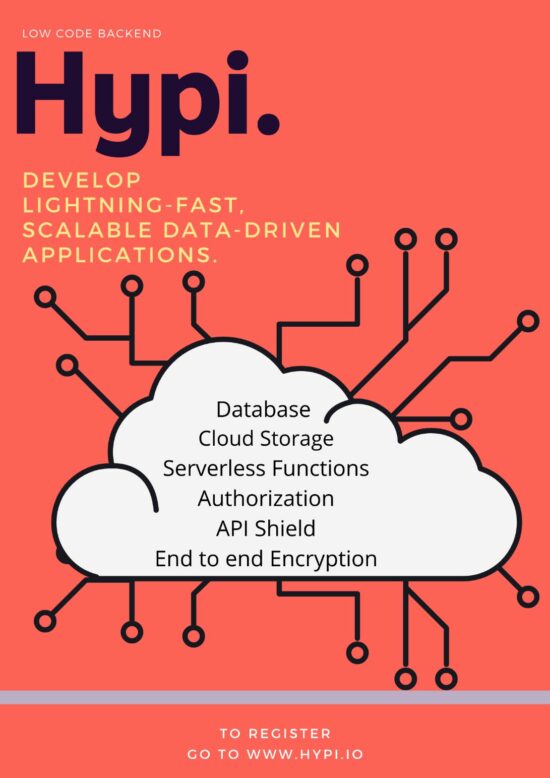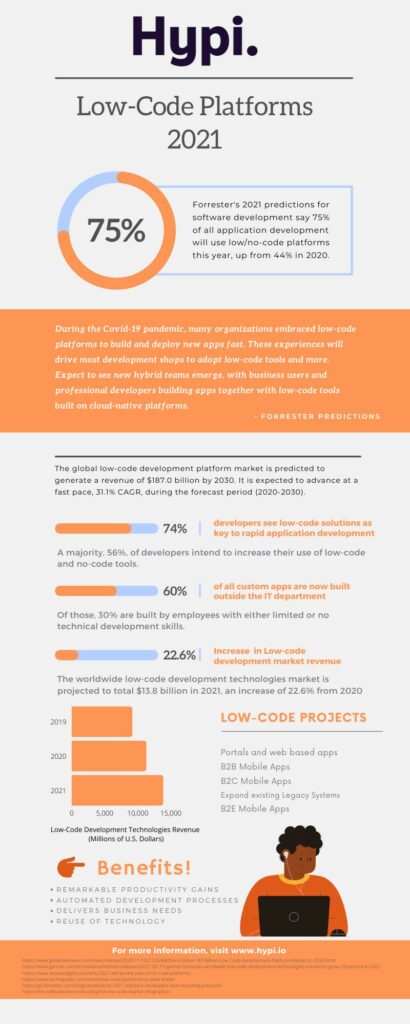Introduction to Low-code and BaaS with Hypi
Year 2021! If a developer is still writing all the code from scratch for developing applications, he is living in the ’90s! We are in the future and the future is low code!
In this article, we will check the features of Low Code first. And then I will introduce you to BaaS (Backend as a Service) and the most feature-rich Low Code backend – Hypi!
What is Low Code?
In the world of software development, low code is an approach to build applications using little to no coding.
Developers are making most of their time by saving development efforts and delivering Apps faster using low code. Citizen developers with no formal training can also use low code to build Apps.
Proficient developers can also use low code to save their efforts. Businesses adopt low code technologies to ship apps faster to the market.
What is Low Code Development Platform?
Low code Development Platform (LCDP) is a visual interface, Integrated Development Environment that facilitates faster development of Applications using little or no code instead of extensive coding.
Why Low Code Platform?
Using a low code platform remarkably improves the productivity of developers. It automates development processes thereby saving time and effort.
So, developers make efficient reuse of available functions provided by the platform.
Every business has a specific need. Low code platform addresses those needs. It provides extensive functionalities to meet the requirements.
A low code platform also lowers the cost of infrastructure needed for application development.
What projects are being delivered using Low Code?
Portals and web-based Apps, B2B, B2C, and B2E mobile apps, and expanding existing legacy systems are some of the projects that are using low code.
These projects generally develop varied applications like customer-facing or employee-facing applications, enterprise applications, and prototyping applications, etc.
Now, take a look at the below Infographic which talks about the points above along with some stats on Low Code Platforms.
Infographic Text
The low code market is growing rapidly. Here are the stats:
- In 2021, 75% of all application development projects will adopt low/no-code platforms. This is a rise of 44% from 2020, says Forrester’s 2021 predictions. 24% of users had no coding experience while using low code platforms.
- 74% of IT professionals believe in adopting low-code solutions to build applications rapidly. 56% of those intend to increase their use of low-code platforms.
- A report says nearly 60% of all customized applications are developed outside the IT department. Employees with limited or no technical skills built 30% of those applications.
- By 2030, it is predicted that the global low-code development platform market revenue will be $187.0 billion which was $10.3 billion in 2019. The forecast period is 2020-2030. During this period, it is expected to increase at 31.1% CAGR.
- The latest forecast by Gartner, Inc mentions that the worldwide low-code development technologies market is projected an increase by 22.6% from 2020 and it will reach $13.8 billion in 2021.
Developers can drive front-end development using low code or access low code backend. Backend as a Service (BaaS) also has low code features.
What is BaaS?
BaaS (Backend as a Service) looks after the backend side development of an application and provides cloud infrastructure. It provides tools to create backend code and automates the development.
Frontend development is just the tip of the iceberg in application development. Backend development takes very much time and effort of the developer. Developers can focus on front-end development leaving the larger portion of Backend functionalities to BaaS providers.

What are the features of BaaS?
BaaS provides cloud storage. Hence, businesses do not have to worry about infrastructure like setting up database servers. Many BaaS providers support serverless computing.
User Authentication, Database Management, File storage are some of the important functions of the backend. BaaS takes care of all these functions.
Hypi – The most feature-rich Low code backend
Now, let me introduce you to Hypi’s low code backend platform!
Hypi is a comprehensive platform that offers various kinds of APIs and functions to build data-driven applications. It is a low code backend as a service (BaaS) platform.
Your front-end application could be built in any language (PHP, JavaScript, Java, Kotlin) or platform (Angular, React, Flutter, Android, iOS, and more). Hypi is language-agnostic as well as platform agnostic.
The applications developed using Hypi’s low code platform are lightning-fast and scalable. Hypi is an API-based platform. APIs developed by Hypi are easy to use and modern in approach. They work as reusable components helping developers minimize efforts to build applications.
What can you do with Hypi?
With Hypi, you can perform Relational Database Queries. It provides Authentication and Authorization for the users. It supports Serverless Computing. So, you can execute serverless functions that are hosted on cloud computing platforms.
For implementing functionalities outside of what Hypi offers, you may write User Defined Functions. Advanced functionalities like WorkFlows, Triggers, WebHooks, REST APIs, File Upload are also available with Hypi’s low code platform.
You may check the comprehensive documentation provided by Hypi to know more about Hypi’s features! Tutorials are available on Hypi’s blog to make it easy for developers to use Hypi.
What does Hypi Offer?
Hypi is a secure platform that offers IaM, permissions for users, and authorization policies to control resources. Individual instances of the App are created. Hence, no two customers will use the same App. They would access individual instances.
JWT based authorization token gets created after successful login. This token is required to access the Hypi functions. So, Hypi is a highly secure platform to use even for applications that handle critical data.
As said earlier, Hypi is a language-agnostic platform. You just need an understanding of GraphQL query language syntax. You may code the front end in any language and leave the backend to Hypi. Hypi also offers serverless computing that makes it a highly flexible platform to use.
Hypi’s built-in storage is scalable and it can meet all your data storage needs irrespective of data volume, variety, or velocity. Hypi NET is a community that connects ideas and developers.
Programming knowledge, software functions, ideas get shared in the Hypi NET community. You may also collaborate development of certain applications.
Hypi works as the Marketplace. Just find what you need and you will come to know that it is already out there. Publish the Apps on the Hypi platform and let prospective customers find them.
How to get started with Hypi?
Hypi has an APP based User Interface. You create building blocks called APP. Each App can work as an npm package/dependency.
You can also create instances from the release and connect your front end to them using Hypi’s API endpoints. You may use Hypi’s Command Line Interface (CLI) to make Hypi part of your workspace.
In Hypi, modeling the schema is your core job – both your data model and API are configured in your App’s schema. Data models are written in GraphQL’s SDL. However, you need not know GraphQL. Hypi’s User Interface makes it easy to build data models.
It is very much user-friendly. Creating tables, editing schema is quite simple with this user interface. It is not necessary to write a code to create a data model. But you may opt to dive into the code and go custom.
Hypi offers various APIs to perform Database Operations like CRUD APIs, Aggregation and Maths APIs, Subscriptions, Password Reminder utility, etc. You may opt to carry out REST operations with Hypi as well.
The typical flow to work with Hypi is
App -> Release -> Schema-> Instance-> Queries/Database Operations-> API Connection-> HTTP requests

Concluding Note
I hope this brief introduction would have taken you to the world of Low code, BaaS, and Hypi!
What are you waiting for?
Start using low code today! Start using Hypi for all your backend needs!


Nice knowledgeable article
Thank you Abdul.